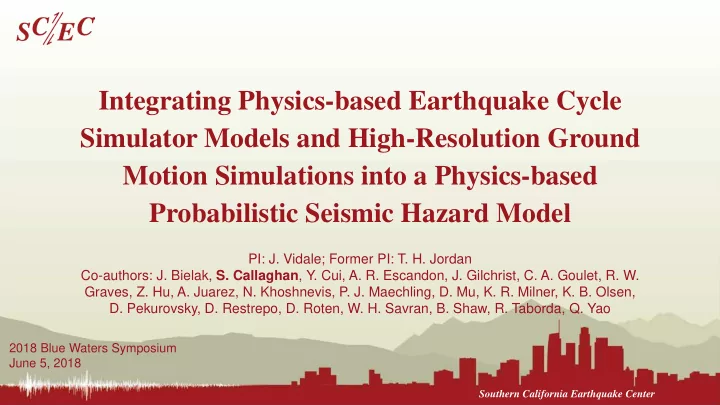

Integrating Physics-based Earthquake Cycle Simulator Models and High-Resolution Ground Motion Simulations into a Physics-based Probabilistic Seismic Hazard Model PI: J. Vidale; Former PI: T. H. Jordan Co-authors: J. Bielak, S. Callaghan , Y. Cui, A. R. Escandon, J. Gilchrist, C. A. Goulet, R. W. Graves, Z. Hu, A. Juarez, N. Khoshnevis, P. J. Maechling, D. Mu, K. R. Milner, K. B. Olsen, D. Pekurovsky, D. Restrepo, D. Roten, W. H. Savran, B. Shaw, R. Taborda, Q. Yao 2018 Blue Waters Symposium June 5, 2018 Southern California Earthquake Center
Probabilistic Seismic Hazard Analysis (PSHA) • What will peak earthquake shaking be over the next 50 years? • Useful information for: • Building engineers • Disaster planners 2% in 50 yrs • Insurance agencies • PSHA performed by 0.4 g 1. Assembling a list of earthquakes 2. Determining how much shaking each event causes 3. Combining the shaking levels with probabilities • SCEC CyberShake simulates ~500k events • Improving the estimates relies on improving the individual steps 7/3/2018 1 Southern California Earthquake Center
Earthquake Rupture Forecasts • Lists of future potential earthquakes come from earthquake rupture forecasts (ERFs) • How big are potential earthquakes? • What faults do they occur on? • How often should we expect them? • Typically produced by aggregating data • Recurrence intervals • Slip and stress rates • Generates logic tree • Can be difficult to capture sufficient variability for simulation 7/3/2018 2 Southern California Earthquake Center
RSQSim • Alternative is to use physics-based approach to simulate ERF • R ate S tate earth Q uake Sim ulator (Richards-Dinger & Dieterich, 2012) • Physics-based multi-cycle simulator • Evolves fault system over time by loading slip and releasing through earthquakes • No prescribed ruptures • Generates catalogs of >1 million years • CPU code with global communication • ~7000 node-hours on Blue Waters for 1Myrs 3000 years of simulated earthquakes (100 years per second) 7/3/2018 3 Southern California Earthquake Center
RSQSim Results • ~275,000 node-hrs used in 2017 • Parameter sweeps • Long catalogs needed to identify cycles and low-probability events • RSQSim results agree closely with empirical approach UCERF2 UCERF3 RSQSim Peak acceleration (g), 2% in 50 yrs 7/3/2018 4 Southern California Earthquake Center
RSQSim Multi-Fault Events Multi-fault ruptures are difficult to investigate historically: not much data Certain combinations of faults are much more likely to rupture together 7/3/2018 5 Southern California Earthquake Center
RSQSim and CyberShake • Coupled RSQSim ERF with CyberShake • Used Blue Waters to produce world’s first end-to-end fully physics- based PSHA results for 6 locations • Performing verification and validation on ruptures • Planning a regional study later in 2018 RSQSim + 3D CyberShake RSQSim + empirical relationship RSQSim + 1D model 7/3/2018 6 Southern California Earthquake Center
High-F • Additional improvements to PSHA come from added physics • Developed as part of SCEC High-F project • Verification and validation with 3 wave propagation codes • 2 finite difference, 1 finite element • M5.1 La Habra event selected for comparison 7/3/2018 7 Southern California Earthquake Center
High-F validation • Simulation results compared against observed seismograms • Identified areas of improvement at higher frequencies • Advances integrated back into CyberShake for improved PSHA Goodness-of-fit maps. Higher numbers (yellows and whites) represent better fit. 7/3/2018 8 Southern California Earthquake Center
SCEC UseIT • SCEC conducts an NSF-funded REU, Undergraduate Studies in Earthquake Information Technology (UseIT) since 2002 • 20-25 students from across the country for 8-week summer program • 44% female • 42% underrepresented minorities • 53% first-generation college students • Students accomplish a ‘grand challenge’ which includes earth science and computer science elements • Since 2016, has included an HPC component on Blue Waters • Goal is to make students aware of HPC as a field 7/3/2018 9 Southern California Earthquake Center
UseIT on Blue Waters • In 2017, interns used Blue Waters to generate RSQSim catalogs • 30,000 node-hours • Performed parameter sweeps • Catalogs used to predict likelihood of large aftershock sequences and losses • Many students now have an interest in HPC careers Magnitude frequency Projected distribution of 4 economic loss RSQSim catalogs with due to a M7.7 on varying frictional the Mojave fault parameters 7/3/2018 10 Southern California Earthquake Center
Blue Waters Plans for 2018 • Building on 2017 Blue Waters accomplishments • Full regional PSHA study using RSQSim • 500,000 node hours • Physics-based PSHA study in Bay Area • 1.5 million node-hours • Integration of additional physics into High-F • Nonlinearity • Topography • Attenuation • UseIT intern class starts next week 7/3/2018 11 Southern California Earthquake Center
Questions? 7/3/2018 12 Southern California Earthquake Center
Recommend
More recommend